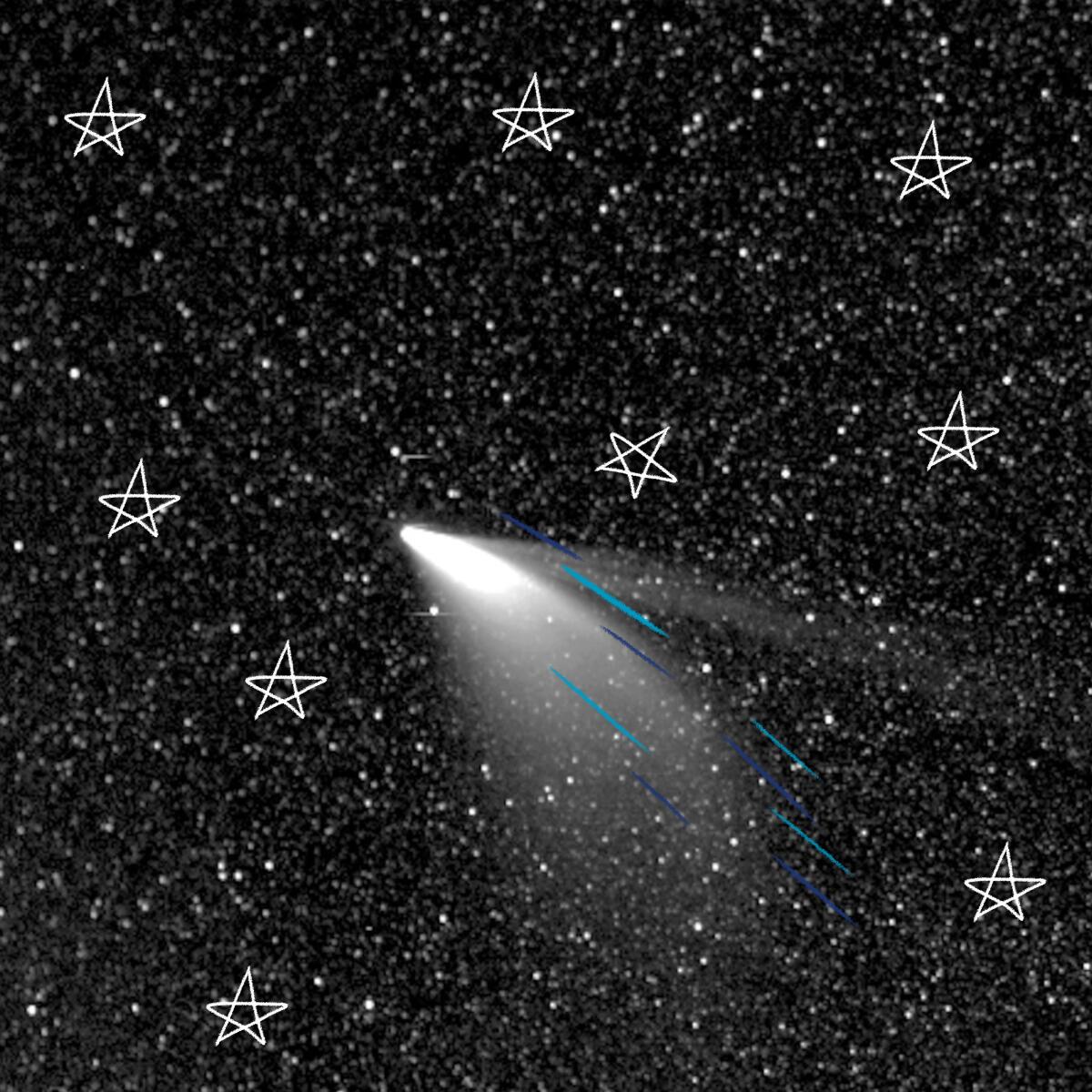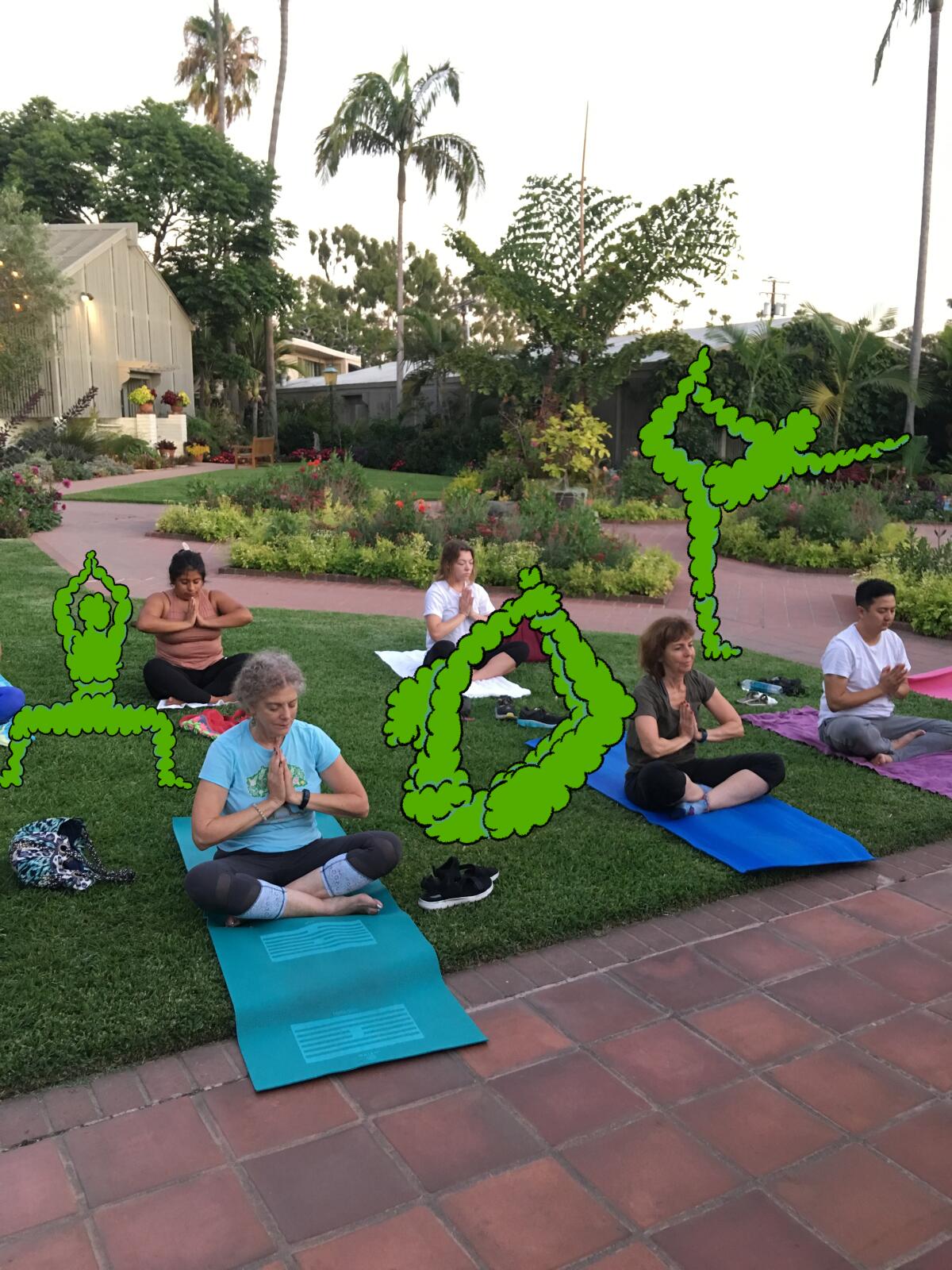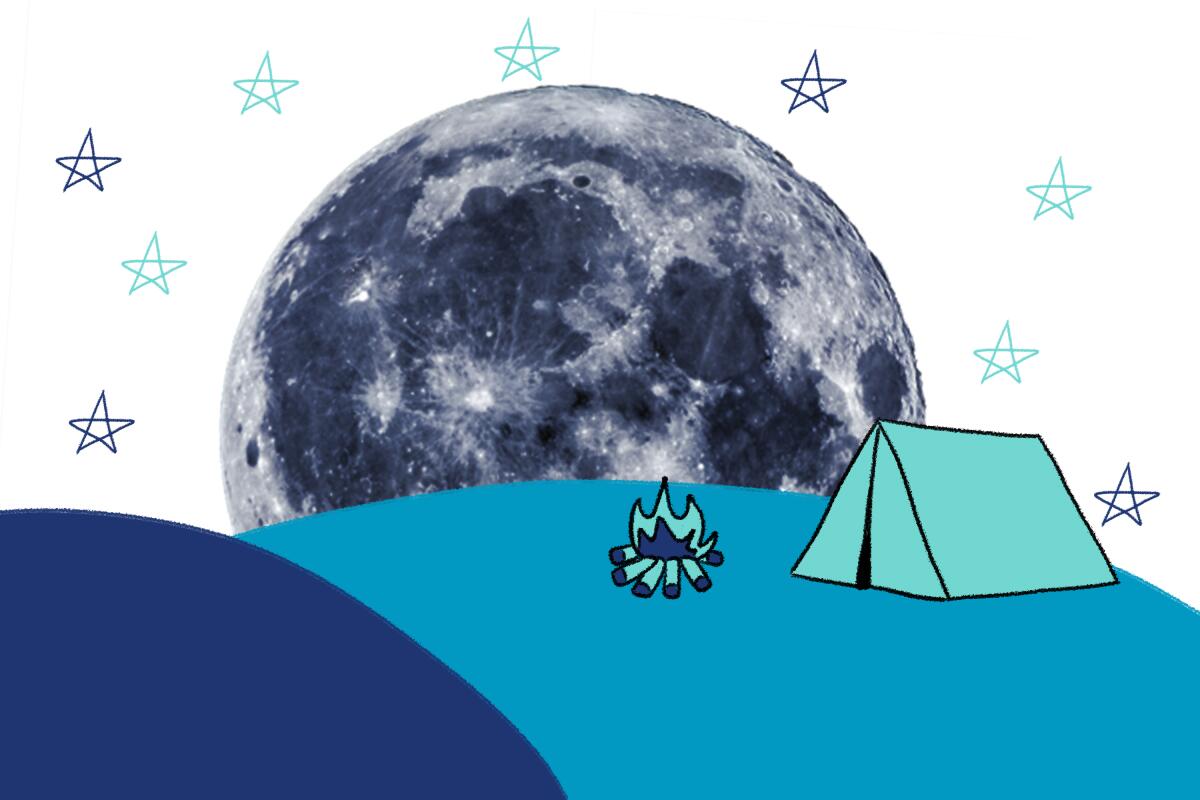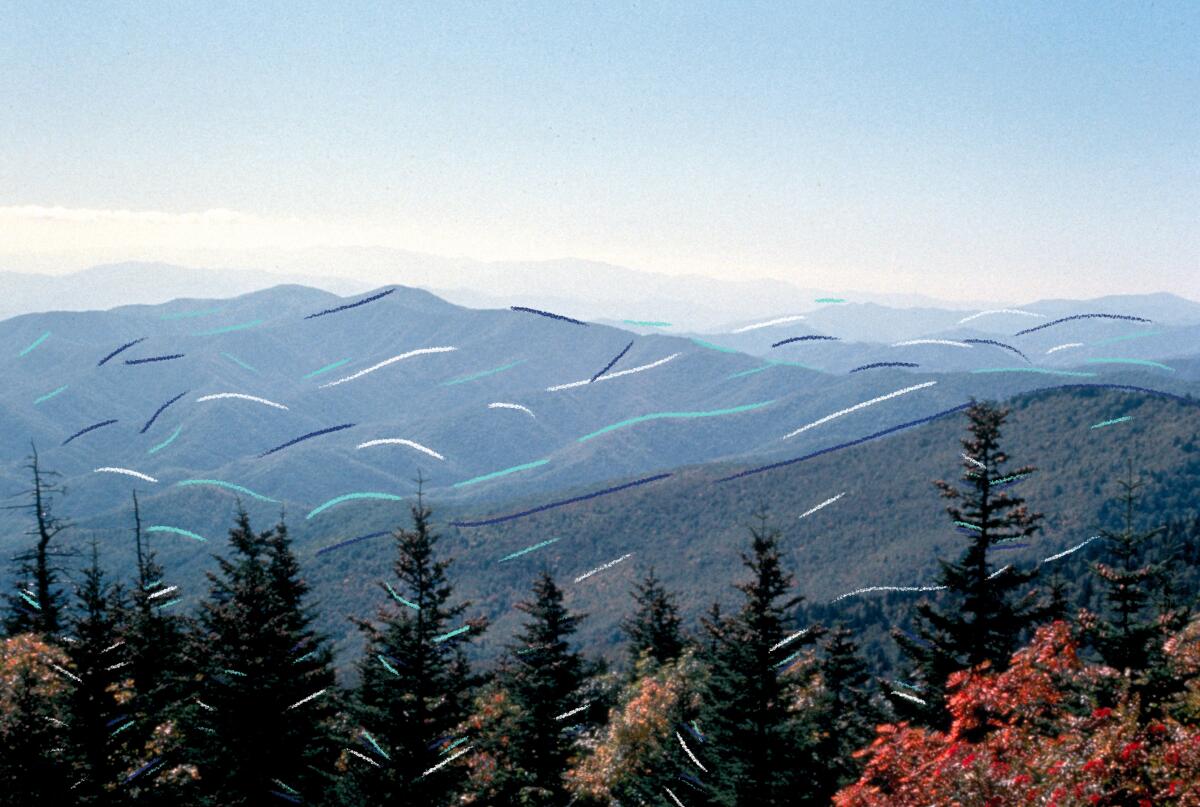See this comet now, or wait 7,000 years

- Share via
Design and illustrations by Micah Fluellen
Sign up here to get The Wild sent weekly to your inbox.
California mostly closed down again this week. The coronavirus has the state on the ropes, prompting the governor to roll back the opening of restaurants, gyms and salons for hard-hit areas. So where does that leave us? Outdoors, of course. Here are three things to do, starting with a spectacular fireball lighting up the sky right now.
1. Look for this comet in the night sky. Comets don’t come streaking our way all that often, at least not bright ones you can see with the naked eye. Many get roasted when they pass close to the sun. That didn’t happen to the Comet NEOWISE. Instead, the glowing beauty with a tail has been wowing watchers since early July. Space.com gives it props for “emphatically” ending a quarter-century drought of spectacular comets.
Last weekend, the comet was visible in the predawn hours. Now it has flipped into evening mode. So peel yourself away from binge-watching on Netflix and look up. If you miss it, this comet won’t be back for about 7,000 years. Here’s what you need to know to see it:
- NEOWISE will be brightest about an hour and a half after sunset between now and Sunday. Look to the north-northwest and it should be about 10 degrees above the horizon. It will come closest to Earth on July 22. More good news: The sky will be good and dark because the moon is in crescent mode and won’t cast light that could ruin your view.
- Reader Isaac Cabrera photographed the comet 9:24 p.m. Tuesday from a point in the San Gabriel Mountains. He created the above photo illustration to show where in the sky to look. “It took me about half an hour to find the comet, since a lot of the guides I looked at online were not particularly helpful,” he wrote in an email. (Camera settings: f1.8, 20mm, 20s (exposure), ISO-400.)
- Find a dark spot away from city lights to watch. That could include nearby high points in the Angeles National Forest, the Santa Monica Mountains and Big Bear Lake. Farther afield, Joshua Tree and Death Valley national parks have super-dark skies that have earned them International Dark Sky Park designations.
- Haze, smoke, clouds and fog banks can be obstacles to seeing NEOWISE too. Keep trying on subsequent evenings.
- You should be able to see NEOWISE with the naked eye, but binoculars or a small telescope could help. Here are some basics for backyard stargazers.
By the way, the comet is officially named C/2020 F3 and nicknamed NEOWISE after the acronym for the NASA space telescope (Near-Earth Object Wide-field Infrared Survey Explorer) that discovered it on March 27.

2. See a California condor in the wild. Mike Maxcy had a twinge of pride when he examined photos of the handful of California condors that recently swooped into Sequoia National Park for the first time in a half-century. Two of the birds had been hatched and raised at the L.A. Zoo. “You get that full-circle feeling,” said the zoo’s curator of birds, who ID’d the condors by their wing tags.
It’s been a wild ride for Maxcy and others who worked on the massive task of heading off extinction of North America’s largest bird for decades. He joined the zoo in 1987 when the last of less than 30 birds left in the wild were captured and brought in for an ambitious captive breeding program. The controversial idea was to raise chicks, train them to flourish in the wild and let them go. Miraculously, it worked.
Last year, the 1,000th chick was born in the wild at Zion National Park. But there were many bumps along the way. Early released birds were electrocuted on power lines; others died after eating carrion laced with lead from bullets (last year California banned hunters from using lead bullets) or drinking radiator fluid.
Now roughly 300 birds soar in Southern California, the Big Sur area, Arizona, southern Utah and Baja, Mexico. An additional 230 thrive in zoo breeding programs. One day, perhaps a condor will again sail over Yosemite’s Half Dome, as it does in a scene depicted on the flip side of California quarters.
Until then, Maxcy and the zoo continue to release condor chicks and run captive breeding programs to bring back other endangered species, such as the mountain yellow-legged frog native to the San Gabriel Mountains that surround Los Angeles. And the faraway Bali myna, which has been diminished by the pet trade in their native Indonesia. Just 100 exist in the wild, but about 1,000 flourish in zoos around the country. “We are Noah’s ark,” Maxcy said. “It’s up to us to keep species thriving.”
Here are places to look for California condors in the wild.

3. Outdoor yoga in the garden. Need to be rescued from your Zoom yoga rut? The Sherman Library & Gardens in Corona del Mar may help. The Central Garden provides the setting for outdoor yoga sessions on Wednesday evenings this summer that include breath work, Hatha yoga and a meditation practice. Class size is limited to allow plenty of room for social distancing. Participants should bring their own yoga mat, a small towel and water. And depending on which session you pick, you can get a glass of wine afterward. Upcoming classes are set for July 22 and July 29, and cost $25 ($20 for members). You must register in advance and wear a mask to class. Go to thesherman.org or call (949) 673-2261.
The must-read

Airports around the world have been pretty much stilled by the coronavirus outbreak. But some people in Singapore are booking rooms at the sprawling Changi Airport just to visit. Huh? “With its butterfly and orchid gardens, custom-made airport fragrance and glass-domed mall housing the world’s tallest indoor waterfall, the experience is considered the gold standard of international airports — a stark example of everything its austere American counterparts are not,” L.A. Times staff writer David Pierson reports. And yes, your chances are good of having a butterfly land on you inside the garden where 1,000 of them flutter around freely. The airport’s indoor tropical retreats haven’t saved it from the harsh economic reality of a 99% drop-off in passengers since April. Still, there’s something quirky and mildly appealing about kicking back at a 130-foot waterfall inside an airport.
The weekly how-to

Over the years, many people have asked me how to make the leap from day hikes to overnight backpacking trips. A million things go through my mind as I try to formulate an easy answer. Fortunately, trail guide Andrew Skurka has a simpler response. Writing on Outside.com, Skurka shares seven tips for planning a successful backpacking trip, starting with asking yourself a basic question: “Why hiking instead of car camping?” Then he gets you thinking about where you want to go, who you want to go with, which gear you’ll need on the trail, what food to bring, etc. He weaves in safety touches good for backpackers at all levels. It’s a nice little read to help anyone get started — and help me whittle down my million thoughts.
Insider tip
Shortly before the pandemic hit the U.S., I took a long train ride from L.A. to Seattle on the Coast Starlight. After leaving downtown, the train swept out to the coast toward Santa Barbara, where I imagined the ocean’s waves were in sync with the rocking train. About 20 hours later, I peered out the window at a thick forest of snowy trees as the train chugged into the Cascade Range, peak after peak whizzing by. Amtrak describes the route as “1,377 miles of sheer magnificence.” I agree; it felt like a grand outdoors sampler. Private roomettes (good for social distancing) for two passengers on the Coast Starlight are on sale until Friday. One way tickets cost $432, or $216 each, which includes meals. Here are the details about how to book Amtrak’s fare sale.
By the numbers

National parks racked up 327.5 million visitors in 2019, a 2.9% increase over the previous year. Where’d we all go? Mostly to the 10 most visited parks in the U.S.
- Great Smoky Mountains National Park, North Carolina and Tennessee, 12.5 million
- Grand Canyon National Park, Arizona, 5.97 million
- Rocky Mountain National Park, Colorado, 4.7 million
- Zion National Park, Utah, 4.5 million
- Yosemite National Park, California, 4.4 million
- Yellowstone National Park, Idaho, Montana and Wyoming, 4 million
- Acadia National Park, Maine, 3.4 million
- Grand Teton National Park, Wyoming, 3.4 million
- Olympic National Park, Washington, 3.2 million
- Glacier National Park, Montana, 3 million
Among other National Park System sites, the Golden Gate National Recreation Area in the Bay Area remained the most visited ahead of the Blue Ridge Parkway, which runs through North Carolina and Virginia.
Among the least visited (where you may escape big crowds) are Pinnacles National Park in Central California (177,224 visitors) and Great Basin National Park in eastern Nevada (131,802 visitors).
Send us your thoughts
What do you think? Keep the comments coming. Share anything that’s on your mind. The Wild is written for you and delivered to your inbox for free. Drop us a line at TheWild@latimes.com.
Click here to view the web version of this newsletter and share with others. I’m Mary Forgione and I write The Wild. I’ve been exploring trails and open spaces in Southern California for four decades.

Sign up for The Wild
We’ll help you find the best places to hike, bike and run, as well as the perfect silent spots for meditation and yoga.
You may occasionally receive promotional content from the Los Angeles Times.




